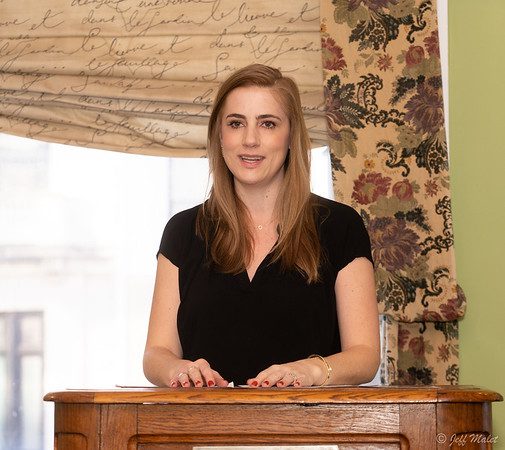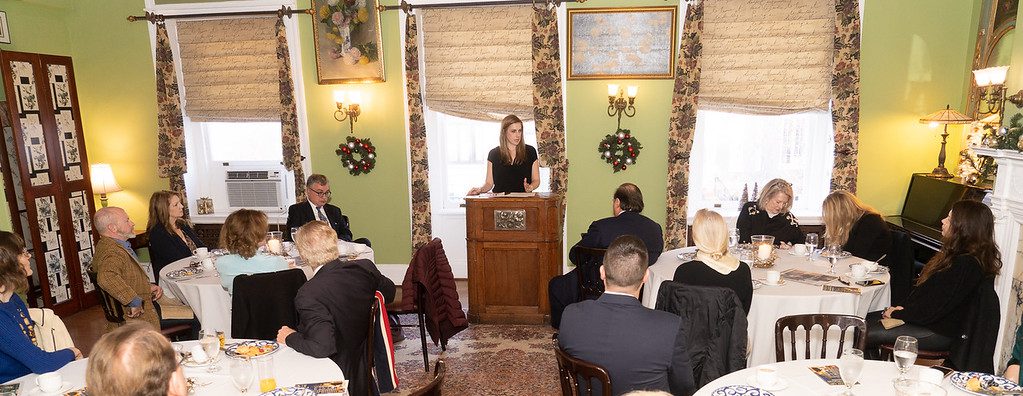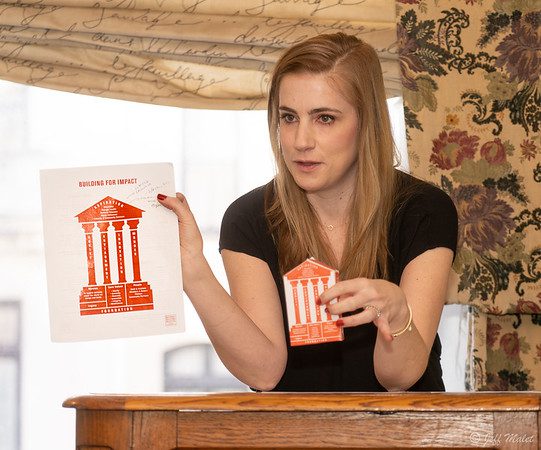Cultural Leadership Breakfast Hosts National Building Museum President
By • December 20, 2021 0 1473

Since its creation by Congress in 1980 to reanimate the immense, near-century-old Pension Building, the National Building Museum has had just five directors (not counting the recent interim stint by Brent Glass, former head of the National Museum of American History). The fourth, Chase Rynd, retired after 17 years during the pandemic lockdown, which extended the museum’s planned closure for renovations.
Number five, President and Executive Director Aileen Fuchs, arrived last May from New York City’s “Forgotten Borough,” Staten Island. On Dec. 16, she joined a group of 20 at the Tabard Inn as the 40th speaker in The Georgetowner’s Cultural Leadership Breakfast Series, which resumed last month.
Though she herself had qualms about relocating in 2017 to Staten Island from Brooklyn — where she was the Brooklyn Navy Yard Development Corporation’s executive director of exhibits and programs — Fuchs is now a booster. “You heard it here,” she said. “Staten Island will be like Brooklyn in 10 years.”
As president and CEO of Staten Island’s Snug Harbor Cultural Center and Botanical Garden, she made sure the 83-acre site, a 19th-century sailors’ rest-home complex saved by “Brooke Astor and Jackie O,” among others, was part of the action. “I had 150,000 visitors come to Staten Island in December” for a winter lantern festival, she reported proudly.

Aileen Fuchs, President and Exec. Dir. of the National Building Museum speaks at the most recent Cultural Leadership Breakfast hosted by The Georgetowner. Photo by Jeff Malet.
Dealing with HVAC issues at thinly staffed Snug Harbor — “crawling in the bowels of these buildings,” she said — became part of a personal journey that reconnected her to the civil engineering legacy of her Middletown, New York, family. When approached about the Building Museum job, though she hadn’t heard of the place, Fuchs felt she had come full circle. And when she saw the spectacular Great Hall, her jaw dropped (as everyone’s does).
The museum was hit hard by its closure for renovations, then Covid, which zeroed out substantial gala-rental income and made the popular Summer Block Party events impossible in 2020. When Fuchs arrived, the staff was down by more than half. “I had to bring a lot of empathy at that time,” she said. A colleague remarked that she was “part of the class of Covid CEOs,” a questionable honor.
But the pandemic, accompanied by heightened concerns about racism and climate change, caused her, like many others, to ask: How do I want to focus my efforts in my life? And she realized that the National Building Museum was well positioned to explore how the built environment — something of an “inside-baseball” term, Fuchs admitted — could contribute to healthier lives, better-functioning communities, a sustainable environment (the building industry, she noted, accounts for 40 percent of global climate emissions), even a more equitable society. The key word: intentionality.
After adjusting to Washington’s October-to-September fiscal year, she developed a three-year plan for growth, emphasizing the museum’s roles of storyteller, policy influencer, public convener and national treasure. Fuchs showed off a small paper box — a stylized miniature of the museum’s foundation, pillars and roof. The four pillars, she explained, were: equity, environment, innovation and wonder.

Fuchs helps her staff at the National Building Museum keep goals of “equity, environment, innovation and wonder” top-of-mind with 3-D architectural constructions. Photo by Jeff Malet.
One area she is currently rebuilding is education, bringing on a vice president of education and engagement and looking to reactivate the “Investigating Where We Live” summer program for D.C. teens, for example. A “measurable impact” is important, she said.
In response to a question about being pulled in different programming directions by donors, board and staff, referencing the museum’s “The Wall/El Muro” exhibition, Fuchs said she highly valued the expertise represented by her 41-member board, which “gives her the room to lead.” Regarding controversial topics (another example: the “Evicted” exhibition of 2019): “We’re not going to shy away from it.”
Pointing out that the national landmark building is mostly appreciated locally, Fuchs said the museum needs to “tell a national story” and “connect the dots between different city projects.” She cited the worldwide C40 Cities group of 97 mayors started by London Mayor Ken Livingstone in 2005 and the Resilient Cities Network as potential partners.
While the extent of pandemic restrictions over the next few months remains to be determined, Fuchs shared that the museum is planning a virtual experience of Notre-Dame de Paris — severely damaged by fire in 2019 and now being reconstructed — in April.
After a good deal of mingling, attendees departed with cards promoting the Jan. 6 kickoff of the museum’s annual Architecture and Design Film Festival DC, featuring a screening of “Mau” and a Q&A with the film’s subject, design visionary Bruce Mau, and his business partner and wife Bisi Williams. On the back was the recipe for “Pensioner’s Punch,” a rum cocktail created by Fuchs, who boasted that she bartended to help pay for graduate school at NYU.

